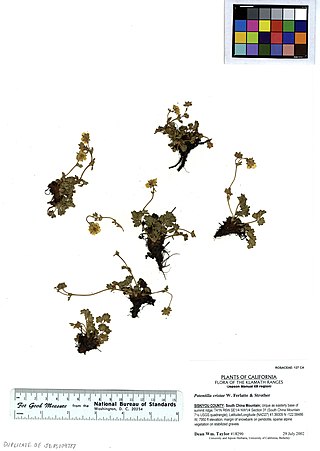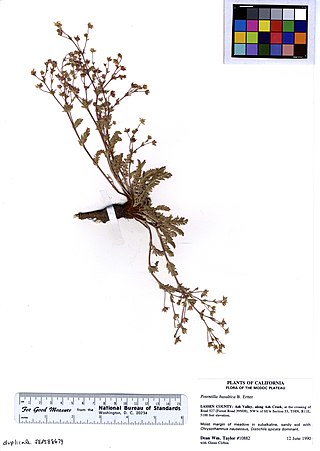
Sibbaldiopsis is a genus in the plant family Rosaceae. This genus only contains a single species: Sibbaldiopsis tridentata, formerly Potentilla tridentata. Commonly, its names include three-toothed cinquefoil, shrubby fivefingers, and wineleaf. Systemic phylogenetic work has placed S. tridentata within Sibbaldia as Sibbaldia retusa.

Potentilla gracilis, known as slender cinquefoil or graceful cinquefoil, is a species of cinquefoil. It ranges from Alaska down the west coast of Canada and the United States, and Colorado.

Potentilla recta, the sulphur cinquefoil or rough-fruited cinquefoil, is a species of cinquefoil. It is native to Eurasia but it is present in North America as an introduced species, ranging through almost the entire continent except the northernmost part of Canada and Alaska.

Potentilla cristae is a rare species of cinquefoil known by the common name crested cinquefoil. It is endemic to the Klamath Mountains of far northern California, where it is known from a few occurrences in the subalpine and alpine climates of the high mountain ridges. It grows in talus and moist rocky or gravelly serpentine soils. This is a low, matted plant producing a clump of hairy, glandular herbage up to about 20 centimeters tall. Each hairy leaf is divided into three rounded leaflets which are toothed or lobed and measure up to 2 centimeters in length. The inflorescence is a cyme of a few flowers, each with five small yellow petals. The fruit is a minute achene just a millimeter wide, which is smooth with a crest.

Potentilla diversifolia or Potentilla × diversifolia is a species of flowering plant in the Rose Family (Rosaceae) known by the common names varileaf cinquefoil, different-leaved cinquefoil, and mountain meadow cinquefoil.

Potentilla flabellifolia is a species of cinquefoil known by the common names high mountain cinquefoil, fanleaf cinquefoil and fan-foil.
Potentilla grayi is a species of cinquefoil known by the common name Gray's cinquefoil.
Potentilla millefolia is a species of cinquefoil known by the common names cutleaf cinquefoil and feather cinquefoil. It is native to Oregon, Nevada and eastern California, where it grows in moist mountain meadows and similar habitat. The plant produces a basal rosette from a taproot, then a decumbent stem up to about 20 centimeters in maximum length. The elongated leaves are made up of several overlapping pairs of deeply lobed leaflets. The inflorescence at the tip of the stem is a cyme of a few flowers, each with usually five yellow petals under a centimeter long.

Potentilla norvegica is a species of cinquefoil known by the common names rough cinquefoil, ternate-leaved cinquefoil, and Norwegian cinquefoil. It is native to Europe, Asia, and parts of North America, and it can be found elsewhere as an introduced species.
Potentilla rimicola is a species of cinquefoil-Potentilla, known by the common name cliff cinquefoil.

Potentilla rivalis is a species of cinquefoil known by the common names brook cinquefoil and river cinquefoil. It is native to much of North America, including the southern half of Canada and the western and central United States. It grows in moist habitat, sometimes in disturbed areas. It is an annual or biennial herb producing upright stems up to half a meter tall from a taproot. The hairy leaves are divided into three to five leaflets which are lance-shaped to oval and lined with teeth. The inflorescence is a cluster of several flowers with tiny yellow petals no more than 2 millimeters long on a calyx of pointed sepals and bractlets which are slightly longer.
Potentilla wheeleri is a species of cinquefoil known by the common name Kern cinquefoil or Wheeler's cinquefoil. It is native to the Sierra Nevada and nearby ranges of California and it has been reported from Arizona and Baja California. Its habitat includes moist areas in mountainous regions. This tuftlike plant produces spreading, decumbent stems with leaves sometimes arranged in a rosette about the caudex. The hairy stems reach a maximum length near 25 centimeters. The rough-haired leaves are palmate, each divided into five wedge-shaped leaflets which are lined or tipped with teeth. The inflorescence is a cyme of several flowers with yellow petals each a few millimeters long.

Potentilla villosa is a species of flowering plant in the rose family, Rosaceae. Its common names include villous cinquefoil, northern cinquefoil, and hairy cinquefoil. It is native to northwestern North America, where its distribution extends from Alaska to Alberta to Oregon. There are records from eastern Asia.
Potentilla cottamii is a rare species of flowering plant in the rose family known by the common names Cottam's cinquefoil and Pilot Range cinquefoil. It is native to Nevada and Utah in the United States. It occurs in the Pilot Range of Elko County, Nevada, and a small area of adjacent Utah.
Potentilla johnstonii is a rare species of flowering plant in the rose family known by the common name sagebrush cinquefoil. It is native to Nevada, where it has been collected from only one spot in the Quinn Canyon Range of Nye County.

Potentilla hippiana is a species of flowering plant in the rose family known by the common names woolly cinquefoil, horse cinquefoil, and Hipp's cinquefoil. It is native to North America, where it occurs in western Canada and the western United States. It occurs in eastern Canada and the US state of Michigan as an introduced species.

Potentilla basaltica is a species of flowering plant in the rose family known by the common names Soldier Meadows cinquefoil and basalt cinquefoil. It is endemic to a small area of the Modoc Plateau and Warner Mountains in northeastern California and northwestern Nevada.
Physaria fremontii is a species of flowering plant in the family Brassicaceae known by the common name Fremont's bladderpod. It is endemic to Wyoming in the United States, where it occurs only in and around the Wind River Range in Fremont County.

Drymocallis glandulosa, formerly Potentilla glandulosa, known by the common names Douglas' wood beauty and sticky cinquefoil, is a plant species in the family Rosaceae.

Drymocallis fissa, the bigflower cinquefoil, also known as the leafy cinquefoil, leafy drymocallis, or wood beauty, is a small plant also sometimes classified as Potentilla fissa. It is a herbaceous plant with a thick taproot known for its moderately hairy leaves, redish leaf stems, and relatively large yellow flowers. It is native to foothills and lower mountains the Rocky Mountain region in the western United States.













